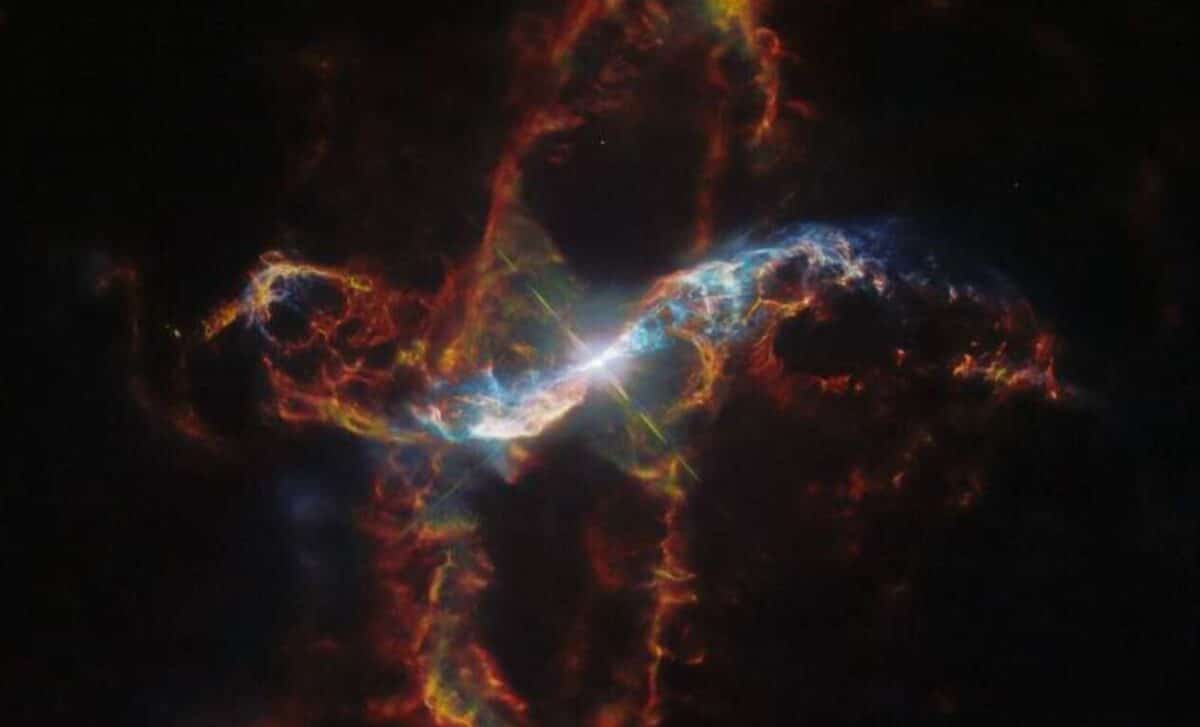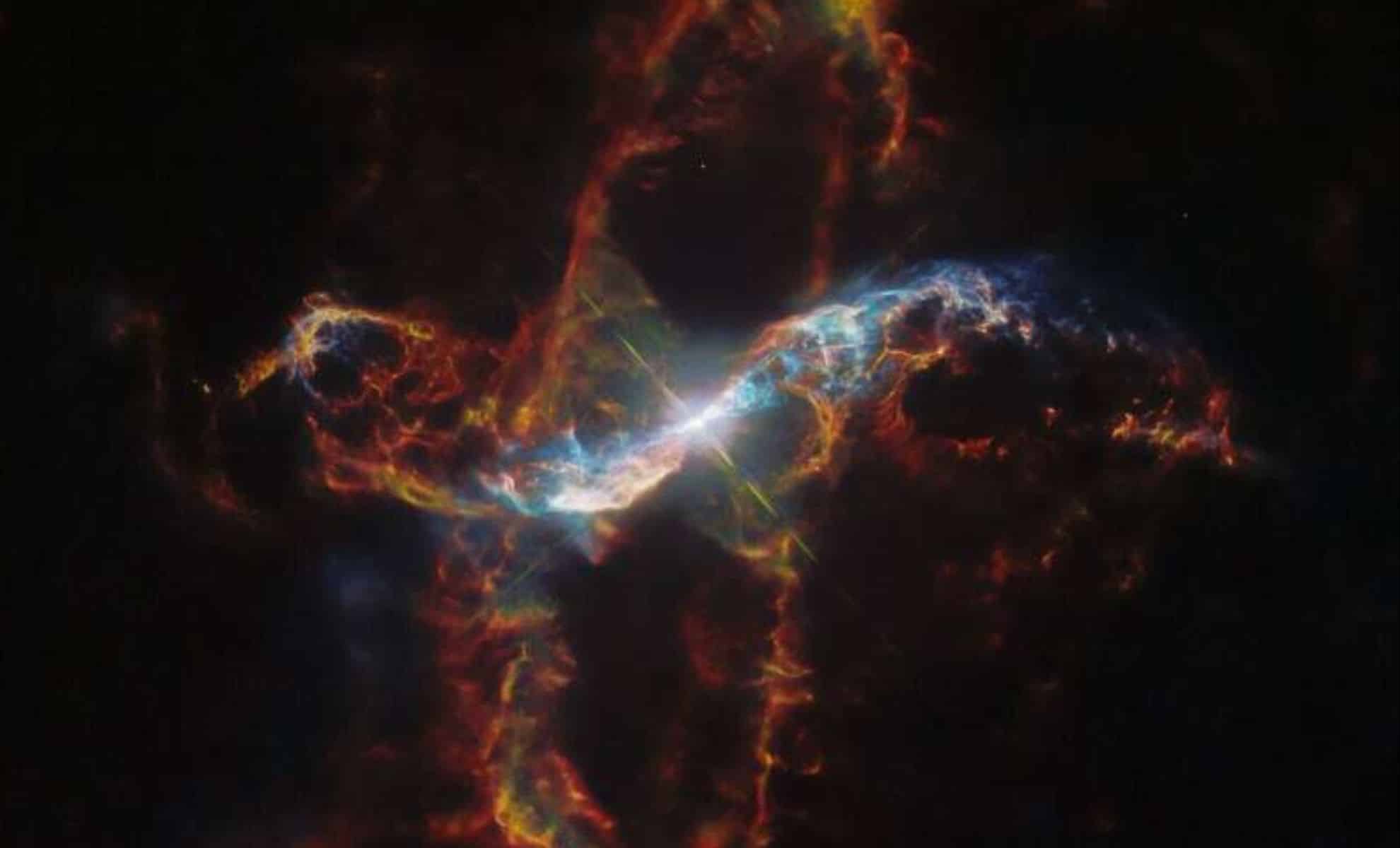The Hubble Space Telescope has captured new, detailed images of the symbiotic binary star R Aquarii, located 700 light-years from Earth. This dynamic system, composed of a red giant and a white dwarf, undergoes frequent thermonuclear outbursts that eject glowing filaments of gas into space. These outbursts offer a unique opportunity for astronomers to study how stars evolve and distribute essential elements like carbon and oxygen throughout the cosmos. Hubble’s observations have provided valuable insights into the life cycles of stars and the cosmic forces that shape the universe.
Hubble Captures Explosive Details of R Aquarii, a Stellar Binary System

NASA’s Hubble Space Telescope has delivered stunning new images of R Aquarii, a rare and complex symbiotic binary star located about 700 light-years from Earth. This unique system, made up of a dying red giant and a small but powerful white dwarf, is known for its violent eruptions, which eject massive amounts of gas and plasma into space, creating a spectacular and ever-changing nebula around the stars.
A Volatile Symbiotic Star System
R Aquarii is part of a rare class of celestial objects known as symbiotic binary stars, where two stars of very different characteristics coexist and interact. In this system, the primary star is a red giant, a massive star that is in the final stages of its life cycle. As red giants expand, they lose mass and shed their outer layers, creating a surrounding nebula. The companion star in this pair is a white dwarf, the dense remnant of a once large star that has exhausted its nuclear fuel. This dynamic interaction between the two stars is what makes R Aquarii particularly fascinating to astronomers.
The red giant in R Aquarii is classified as a Mira variable, a type of pulsating star that undergoes extreme fluctuations in brightness. Over the course of its pulsation period of about 390 days, the star changes its luminosity by a factor of up to 750 times. At its brightest, it shines with a luminosity nearly 5,000 times greater than our Sun. This variability in brightness reflects the complex internal processes within the red giant, as it grows increasingly unstable towards the end of its life.
Meanwhile, the white dwarf orbits the red giant in a highly elliptical orbit, with a period of 44 years. As the white dwarf moves closer to its giant companion, it begins to siphon hydrogen gas from the red giant’s outer layers. This gas accumulates on the surface of the white dwarf until it reaches a critical point, triggering a thermonuclear explosion. The explosion causes an outburst of plasma, which is expelled into space at speeds exceeding 1 million miles per hour, creating the dramatic filaments and loops of gas seen in Hubble’s latest images.
Hubble’s Long-term Observations of R Aquarii
The Hubble Space Telescope has been monitoring R Aquarii since 1990, capturing detailed images of the star system’s explosive activity. The system’s dynamic behavior has been documented over decades, allowing scientists to witness the changes in real-time. The latest set of observations, spanning from 2014 to 2023, has been compiled into a unique timelapse video released by the ESA/Hubble team. This timelapse reveals the rapid evolution of the nebula surrounding R Aquarii, showcasing the glowing filaments of gas twisting into a spiral as they are shaped by the white dwarf’s eruptions.
The timelapse also highlights the pulsations of the red giant, which brighten and dim dramatically as its outer layers expand and contract. These pulsations are visible in the diffraction spikes surrounding the stars in Hubble’s images, with the red giant’s variability affecting the entire nebula’s brightness. The material ejected during the white dwarf’s outbursts forms trails and loops that extend outward from the binary system, twisting into intricate shapes as they are funneled along magnetic field lines. The outflow of material is so powerful that it can be traced out to 400 billion kilometers from the star system—equivalent to 2,500 times the distance between the Sun and Earth.
The Hubble team’s observations have also allowed scientists to study the Cederblad 211 nebula, the large cloud of gas and dust that surrounds R Aquarii. This nebula is believed to be the remnant of a past nova event, a massive stellar explosion that occurred when the white dwarf underwent a previous thermonuclear outburst. The nebula’s complex structure, shaped by the interactions between the two stars, is illuminated by the intense radiation from the white dwarf’s explosions, providing a vivid demonstration of the recycling of stellar material back into space.
Understanding R Aquarii’s Importance
R Aquarii’s frequent outbursts and relative proximity to Earth make it an ideal laboratory for studying the late stages of stellar evolution. The system’s interactions offer a rare glimpse into the processes that occur when stars like the Sun reach the end of their life cycles. By observing R Aquarii, astronomers can better understand how stars shed their outer layers and enrich the interstellar medium with heavy elements such as carbon, nitrogen, and oxygen. These elements, formed deep within the cores of stars, are crucial for the formation of planets and the development of life.
The violent outbursts from R Aquarii also provide insight into the behavior of white dwarfs, which can undergo multiple cycles of mass accumulation and thermonuclear explosions. These cycles are of great interest to astronomers, as they offer clues about the processes that could eventually lead to more catastrophic events, such as supernovae. Supernova explosions are responsible for dispersing large quantities of heavy elements throughout the galaxy, playing a key role in the evolution of galaxies and the formation of new stars and planetary systems.
Hubble’s ability to capture the detailed structure of R Aquarii’s outbursts has transformed our understanding of these processes. The observations show how the plasma jets emitted by the white dwarf are twisted into a spiral pattern by the system’s strong magnetic fields. The glowing filaments, energized by the radiation from the binary stars, stretch across vast distances, creating a visually stunning display of cosmic forces at work.
Looking to the Future
The continuing study of R Aquarii will remain a priority for astronomers as they seek to unravel the mysteries of symbiotic stars and the complex interactions that drive their behavior. With the upcoming launch of the James Webb Space Telescope (JWST), scientists hope to gain even deeper insights into the processes occurring within these binary systems. The JWST’s advanced infrared capabilities will allow researchers to peer through the dust and gas surrounding R Aquarii, revealing details that have been hidden from view.
Additionally, the long-term monitoring of R Aquarii by Hubble will provide a more complete picture of the system’s evolution over time. By studying how the interactions between the red giant and white dwarf change over decades, astronomers can refine their models of stellar evolution and gain a better understanding of the life cycles of stars.
As researchers continue to observe R Aquarii and similar systems, they will build a more comprehensive understanding of the role that symbiotic stars play in the chemical enrichment of the universe. These systems, though rare, provide valuable clues about the processes that govern the formation and destruction of stars, planets, and the very building blocks of life.



